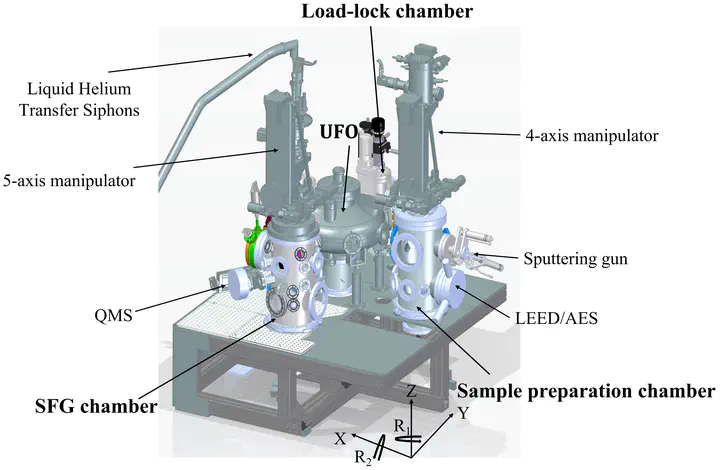Our latest paper, titled ‘Integration of conventional surface science techniques with surface-sensitive azimuthal and polarization dependent femtosecond-resolved sum frequency generation spectroscopy’, is out now in Review of Scientific Instruments as an Editor’s Pick
Our recent publication, titled ‘Integration of conventional surface science techniques with surface-sensitive azimuthal and polarization dependent femtosecond-resolved sum frequency generation spectroscopy’, is out now in Rev. Sci. Instrum. It was further selected as an Editor’s Pick.
 Image credit: Zhipeng Huang
Image credit: Zhipeng Huang
The renowned physicist Wolfgang Pauli once said, “God made the bulk; the surface was invented by the devil.” Studying the properties of surfaces is challenging, especially their ultrafast non-equilibrium dynamics. However, studying surfaces is important, as they lay the foundation for heterogeneous catalysis, heterostructure devices, 2D materials, etc.
Femtosecond angle-resolved photoemission, ultrafast low-energy electron diffraction, ultrafast grazing incidence X-ray scattering, ultrafast infrared reflection and surface-enhanced Raman spectroscopy have been used and play main roles in studying the ultrafast non-equilibrium dynamics of surfaces. If the surfaces are buried, for example, in solid-bulk liquid interfaces or heterostructure bulk junctions, applying electron-based ultrafast characterization techniques to these systems can be challenging due to their small penetration depth. Ultrafast sum-frequency generation nonlinear spectroscopy (SFG) shows its advantage for these systems. SFG probes the second-order susceptibilities χ(2) of the materials. It equals zero for centrally symmetric bulk materials, thus providing surface and interface sensitivity.
In this contribution, we reported the development of an ultra-high vacuum setup that integrates conventional surface science techniques with azimuthal and polarization-dependent, femtosecond time-resolved sum-frequency generation spectroscopy and scanning sum-frequency generation microscopy. With a series of proof-of-principle measurements of CO adsorbed on Pt(111) and of the clean Ag(111) surface, we demonstrate that the setup offers 34 fs temporal resolution to perform time-resolved SFG spectroscopy, sufficient manipulator stability to perform scanning SFG microscopy on ~40 μm length scales, and flexible sample rotation to perform azimuthal-dependent SFG spectroscopy. This setup allows for the full characterization of the nonlinear susceptibility under equilibrium and femtosecond optically excited non-equilibrium conditions, as well as temperature control and sample preparation/characterization of conventional UHV setups.
Building a setup combining several ultrahigh vacuum chambers with sophisticated laser beam paths from scratch is challenging. We hope this contribution will be of interest to scientists in the fields of surface science, physical chemistry, materials science, etc.
There is the link of the publication. The full article can be found at this link.